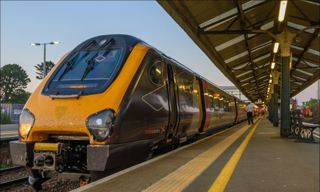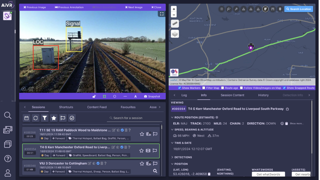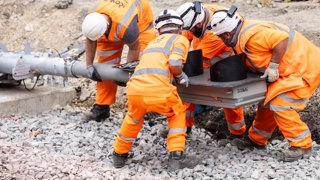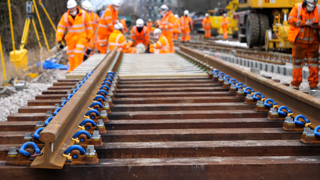In February, I enjoyed a few days off exploring Newcastle upon Tyne and some of the surrounding area - an interesting place from a railway perspective.
The fully electrified Tyne and Wear Metro was until recently the UK’s second most-used light rail network.
In February, I enjoyed a few days off exploring Newcastle upon Tyne and some of the surrounding area - an interesting place from a railway perspective.
The fully electrified Tyne and Wear Metro was until recently the UK’s second most-used light rail network.
The East Coast Main Line was fully electrified in the late 1980s - including the stunning Grade 1 listed Newcastle Central station (the wires are discreet and do not detract from the architecture), and the mighty Grade 2 listed King Edward VII bridge across the River Tyne.
On other lines, late 1980s diesel trains are still in service.
Today, decarbonisation is cited as the main reason for electrifying our railway lines. This overlooks many of the other benefits, which take advantage of rail’s unique ability to provide unbroken electrical supply to its vehicles: rapid acceleration; reliable and proven train designs; reduced weight impact on the track. All result in reliable, high-capacity services with lower lifetime costs.
We have a lower percentage of electrified rail network than nearly all other European countries.
Electrification investment has seen feast and famine, with almost none in the late 1990s and 2000s, then the highest ever rate in the 2010s.
Cost overruns (particularly on the Great Western electrification programme), coupled with an industry that had lost the skills and experience to electrify, have led to a backlash. This is despite Network Rail having learnt many lessons since - particularly in Scotland because of sustained government commitment, where it is achieving its best ever costs per track kilometre in the ongoing electrification of the East Kilbride line.
Despite this progress, the industry is embracing the idea of discontinuous or partial electrification, including for fast and busy main lines.
This approach proposes a patchwork of shorter sections of electrification, with batteries fitted to trains to bridge the gaps, instead of continuous provision of 25KV overhead line equipment.
The advantage is stated as reduced upfront capital cost, particularly in relation to modifications to (or demolition of) structures to accommodate electrification.
Some industry contacts state they would ideally prefer full electrification. But the historic, current, and anticipated future failure to invest in this means that it’s considered unviable, particularly given Treasury approaches to business case appraisal.
However, I am unconvinced by the proposed default adoption of partial electrification and battery trains, for three key reasons. It remains untested at-scale. It risks worsening reliability and capability. And it may have greater whole-life costs.
Firstly, the partial electrification approach is largely untried and untested.
Other countries have so far used it only for the operation of battery trains on secondary lines with low line speeds or low frequencies. The continued expansion of full electrification is a far more common approach, such as in Denmark.
If partial electrification and battery trains is such a great idea, why are so few other places doing it?
In the UK, electric-battery hybrid units are in service only for a one-mile section of Merseyrail, and a couple of units in service in South Wales.
These instances of battery deployment have not proved its suitability for East West Rail (for example), which is planned to have four trains per hour in each direction and 100mph line speeds.
There is currently no convincing answer as to how rail freight, for which the government has set ambitious growth targets, could be powered using partial electrification and battery locomotives.
Secondly, introducing such a new approach to traction power at the scale proposed risks worsening system reliability and capability.
We have limited history of (and therefore data on) the reliability of electric-battery trains at scale.
Regular switching between overhead power and battery will require more complicated interfaces between infrastructure and rolling stock than full electrification, using an existing mechanism of trackside balises sending instructions to the train on when to raise and lower pantographs. Trains will gain complexity, requiring two traction power methods and systems.
I understand that modelling indicates that battery trains have significantly inferior acceleration above 50mph compared with electric trains.
In cases of major disruption and trains stranded in areas without overhead wires, there are risks around batteries’ ability to provide power for heating, air-conditioning, and other on-board systems for long periods of time.
Finally, I remain unconvinced that partial electrification and battery trains has a better whole-life cost than full electrification for most lines. While suitable for low speed and low frequency branch lines, battery trains as standard will mean higher rolling stock capital or leasing costs, as they are more complicated than an electric-only train.
There will still be considerable cost from the feeding or cabling arrangements to connect distant or separate segments of partial electrification. Batteries on trains will need periodic replacement, and result in missed opportunities for reducing track tonnages compared to all-electric alternatives.
An illustration of where I diverge from industry thinking is the West Country. I understand it is being proposed to discontinuously electrify the main line route of Newbury-Penzance, with inter-city trains running as electric-battery hybrids, and battery trains on the branches.
I am told that Bristol Temple Meads would be too expensive to justify for electrification, requiring all trains serving it to be equipped with batteries. Yet British Rail was able to discreetly electrify many old and beautiful stations, such as Newcastle Central, York and Glasgow Central.
My alternative view is that Newbury-Penzance should be fully electrified as an important inter-city main line - as should all main lines serving Bristol Temple Meads, and most diversionary routes.
That would mean fully electric trains and locomotives on all main passenger and freight routes, while enabling battery trains on the branch lines. The busiest branches, such as Exmouth and Paignton, would also make sense for full electrification.
I call on the government to commit to a rolling programme of full electrification, with a specified amount per year for the next 30 years. This will give industry and supply chains confidence and enable Network Rail to continue its progress in reducing unit costs.
In the meantime, government policies and Treasury approaches to business case appraisal are forcing the industry to pursue electrification methods for even some of our busiest railways that are not being embraced elsewhere.
Olly Glover is the LIberal Democrat MP for Didcot and Wantage.
Login to continue reading
Or register with RAIL to keep up-to-date with the latest news, insight and opinion.

















Login to comment
Comments
No comments have been made yet.